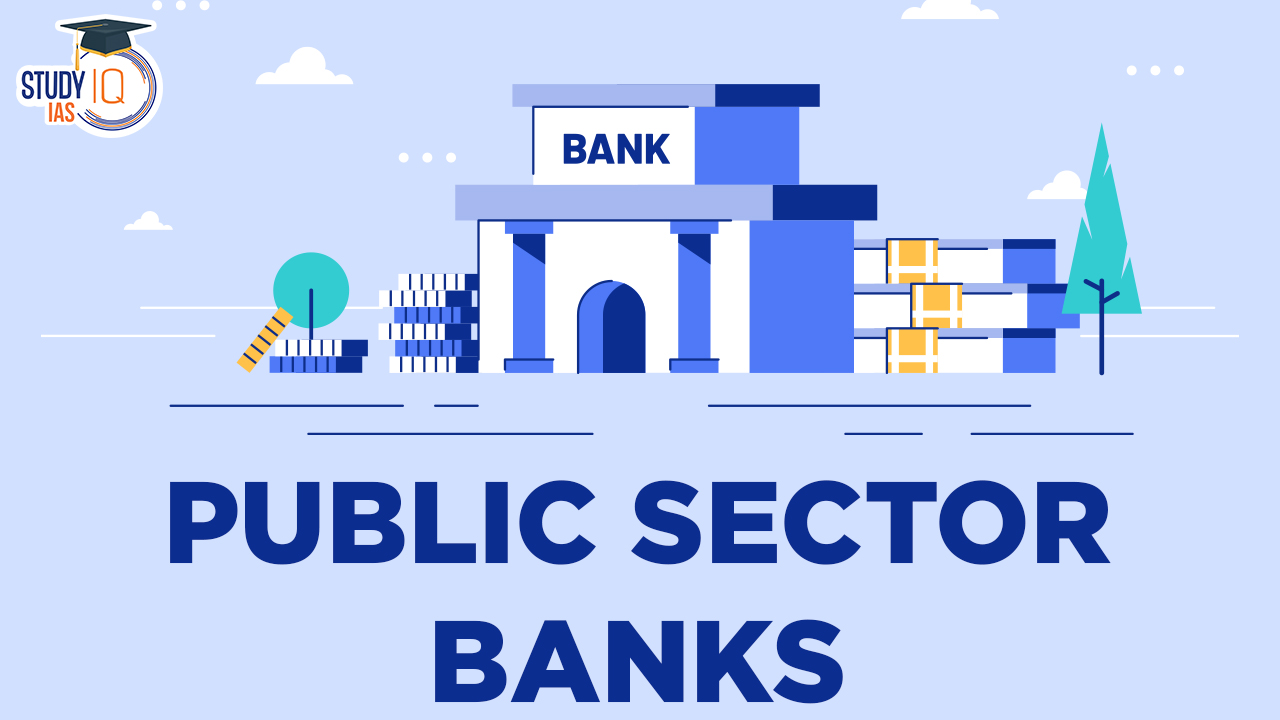Table of Contents
Public Sector Banks
Public Sector Banks are financial institutions that are owned and operated by the government. These banks play a significant role in the economy by providing banking services to individuals, businesses, and government entities. Public sector banks are responsible for mobilizing savings, facilitating credit, promoting financial inclusion, and supporting economic development.
Read about: Banking System in India
Public Sector Banks in India History
Public Sector Banks in India have a significant historical perspective. Here are some key points:
Nationalization
In 1969, the Indian government nationalized 14 major private banks, transforming them into public sector banks. This move aimed to enhance financial inclusion, mobilize resources for economic development, and promote social welfare.
Expansion
Following nationalization, public sector banks underwent significant expansion across the country. Branch networks were established in rural and remote areas, making banking services more accessible to the general population.
Priority Sector Lending
Public sector banks played a crucial role in promoting priority sector lending. They were directed to allocate a specific percentage of their lending to sectors such as agriculture, small-scale industries, and marginalized sections of society to support inclusive growth.
Social Development Initiatives
Public sector banks have been actively involved in various social development initiatives. They have contributed to poverty alleviation programs, rural development schemes, financial literacy campaigns, and government-led initiatives such as Pradhan Mantri Jan Dhan Yojana and Mudra Yojana.
Reforms and Consolidation
Over the years, public sector banks have undergone reforms to enhance governance, improve asset quality, and strengthen their financial position. In recent times, there has also been a push towards bank consolidation to create stronger and more efficient entities.
Technological Advancements
Public sector banks have embraced technology to improve operational efficiency and customer service. They have implemented online banking, mobile banking, and digital payment systems, providing convenience and accessibility to customers.
Government Ownership
Public sector banks continue to be predominantly owned by the Indian government. The government plays a significant role in their governance, capital infusion, and policy direction.
Read about: List of RBI Governors of India
State Bank of India
State Bank of India (SBI) is the largest public sector bank in India and one of the largest banks in the country. Here is some key information about SBI:
| State Bank of India | Details |
| History | SBI traces its roots back to 1806 when the Bank of Calcutta, the first bank in India, was established. It later evolved into the Bank of Bengal and eventually became the Imperial Bank of India in 1921. In 1955, it was nationalized and renamed the State Bank of India. |
| Size and Network | SBI has a vast network of branches and ATMs across India and has a significant presence internationally as well. As of March 2021, SBI operated over 22,100 branches and more than 58,500 ATMs throughout the country. |
| Services | SBI offers a wide range of banking and financial services to individuals, businesses, and corporate clients. It provides savings and current accounts, loans, insurance, investments, wealth management, and digital banking services. |
| Subsidiaries | SBI has several subsidiaries, including SBI Life Insurance, SBI Mutual Fund, SBI Cards, SBI Capital Markets, and SBI General Insurance, among others. These subsidiaries provide specialized services in their respective domains. |
| Financial Inclusion | SBI has played a significant role in promoting financial inclusion in India. It has implemented various initiatives and programs to reach underserved areas and provide banking services to the unbanked population. As of March 2021, SBI had opened over 43.5 crores (435 million) of basic savings bank deposit accounts under its financial inclusion drive. |
| Technological Advancements | SBI has embraced technological advancements in banking. It offers online and mobile banking services, allowing customers to perform transactions, access account information, and avail of various banking services digitally. SBI’s YONO (You Only Need One) platform has gained popularity, providing a wide range of banking and lifestyle services in a single app. |
| Government Ownership | SBI is a public sector bank with majority ownership by the Indian government. The government holds a controlling stake of around 57.63% in the bank, ensuring public control over its functioning and policies. |
SBI’s size, extensive network, and range of services make it a prominent player in the Indian banking sector. It continues to be a trusted and reliable institution, contributing to the growth and development of the Indian economy.
Read about: Types of Banks in India
Public Sector Banks Advantages
Public sector banks offer several advantages, including:
Financial Inclusion
Public sector banks expand banking services to remote areas, promoting financial inclusion for underserved populations. For example, State Bank of India has over 22,000 branches, enabling wider access to banking facilities.
Government Backing
Public sector banks enjoy government support, ensuring stability and confidence for depositors and investors.
Social Welfare
These banks actively participate in social welfare initiatives, such as priority sector lending. Around 40% of public sector bank lending is directed towards sectors like agriculture, micro, small, and medium enterprises (MSMEs), benefiting the overall economy.
Affordable Credit
Public sector banks often provide loans at competitive interest rates, making credit more accessible and affordable. For instance, Canara Bank offers home loans at attractive rates, facilitating homeownership.
Long-term Financing
Public sector banks have the capacity to provide long-term financing for infrastructure projects. For instance, Punjab National Bank has supported infrastructure development with loans exceeding Rs. 1.75 lakh crore (around $23.7 billion).
Stability
Public sector banks demonstrate stability during economic downturns due to government ownership and regulations. This helps maintain the stability of the banking system and protects depositor interests.
Job Creation
Public sector banks are significant employers, generating numerous job opportunities. State Bank of India alone employs over 2.4 lakh employees, contributing to employment generation in both urban and rural areas.
Customer Service
Public sector banks prioritize customer service and accessibility. They aim to cater to a diverse range of customers, ensuring efficient and satisfactory banking experiences.
These advantages showcase the crucial role public sector banks play in financial inclusion, social welfare, and economic development in India.
Read about: Indian Financial System
Public Sector Banks Disadvantages
Public sector banks have certain disadvantages, which include:
Bureaucratic Processes
Public sector banks are often criticized for bureaucratic red tape, resulting in slower decision-making. This can hinder their ability to respond swiftly to market changes and customer needs.
Government Interference
Government ownership can lead to political interference in the operations of public sector banks. This can impact their autonomy and decision-making processes.
Limited Flexibility
Public sector banks may face limitations in terms of flexibility and agility compared to their private sector counterparts. This can affect their ability to adapt to changing market dynamics and implement innovative strategies.
Capital Constraints
Public sector banks sometimes face capital constraints due to reliance on government capital infusion. Insufficient capital can restrict their lending capacity and hinder their ability to meet regulatory requirements.
Competitiveness
Public sector banks may face challenges in offering competitive products and services compared to private banks. This can affect their ability to attract customers and retain market share.
Efficiency and Productivity
Public sector banks often have higher operating costs and lower efficiency compared to private banks. According to a report by the Reserve Bank of India, public sector banks had a cost-to-income ratio of around 57% in 2020, higher than the 48% for private sector banks.
Non-performing Assets (NPAs)
Public sector banks have faced challenges in managing non-performing assets, which are loans that are in default or at risk of default. As of March 2021, public sector banks in India had a gross NPA ratio of around 8.5%, higher than the 4.5% for private sector banks.
Read about: India’s GDP Growth Rate
Public Sector Banks UPSC
Public Sector Banks (PSBs) in India are vital for UPSC exam preparation, covering topics in the UPSC Syllabus like economics, governance, and banking sector policies. PSBs play a significant role in financial inclusion, economic development, and government reforms. Aspirants can enhance their knowledge through UPSC Online Coaching and by taking the UPSC Mock Test that assesses their understanding of PSBs and related reforms.
Read about: Finance Ministers of India List


 Goods and Services Tax (GST), Objectives...
Goods and Services Tax (GST), Objectives...
 World Oceans Day 2025, History, Theme, S...
World Oceans Day 2025, History, Theme, S...
 World Environment Day 2025, Theme, Histo...
World Environment Day 2025, Theme, Histo...





















